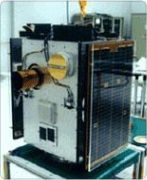닫기
| 인공위성연구센터 소개 | 인공위성관련 정보 | 연구개발 | 인력 양성 | 연구개발시설 | 산업기술지원 | 정보나눔 |
|---|---|---|---|---|---|---|
|
인사말 설립목적과 비전 연혁 조직도 찾아오시는 길 |
인공위성소개 - 인공위성 개요 - 주요 임무 - 내부구조 - 위성체조립 - 환경시험 - 발사 위성개발역사 |
우리별 위성 개발 - 우리별 1호 - 우리별 2호 - 우리별 3호 과학기술위성 개발 - 과학기술위성 1호 - 과학기술위성 2호 - 나로과학위성 - 과학기술위성 3호 차세대 소형위성 개발 초소형위성 군집시스템 개발 핵심우주기술 개발 - 다기능 구조체 - 고성능 탑재컴퓨터 개발 - 홀 추력기용 연료공급장치 - 리튬-이온 배터리 - 초소형 영상 분광기 - 고속데이터 시뮬레이터 과거수행 프로젝트 |
캔위성 체험·경연대회 뉴스페이스 리더 양성 - 사업 개요 - 사업 운영 - FAQ |
지상국 청정실 진동시험기 열진공 챔버 |
환경시험지원 - 진동시험 - 열진공/주기시험 |
공지사항 채용공고 사진자료실 |
| 전체메뉴닫기 | ||||||

Research and Development
KITSAT-3
▶ HOME > Research and Development > KITSAT Series > KITSAT-3

∎ KITSAT-3
Launched on May 26, 1999, KITSAT-3 was the first independently designed Korean satellite with a unique system developed by SaTReC, building on the experience gained from the KITSAT-1 and KITSAT-2 projects. It demonstrated performance on par with leading small satellites developed in more advanced nations, drawing global attention.KITSAT-3 took Earth images of various parts of the world in full color and conducted high energy particle detection and electron temperature measurement experiments to observe changes in the space environment. It also verified the space performance of domestically manufactured semiconductors.
The successful launch and operation of KITSAT-3 holds great meaning as Korean researchers independently developed and verified core space technologies in real missions.
- To develop a unique 3-axis attitude stabilized small satellite system
- To develop a high resolution (13M) Multispectral Earth Imaging System (MEIS)
- To observe changes in the space environment according to solar activity
- Space verification of domestically produced components such the large capacity memory system
| Orbit | 730 km circular sun-synchronous orbit |
| Size | 495x604x852 mm |
| Weight | ~ 110 kg |
| Power Rating | Max. 180 W |
| Attitude Control Method | 3-axis stabilization, magnetic torquer, < 0.5 deg pointing accuracy |
| Communication (Transfer Speed) |
VHF-band Uplink (148 MHz frequency band): 9600bps UHF band Downlink (401 MHz frequency band): 9600bps X-band transmitter: 3.3 Mbps |
| Main Computer | KASCOM(80960) |
| Payloads |
Multispectral Earth Imaging System (MEIS) 15M resolution, 3 channels, linear CCD camera Space ENvironment Scientific Experiment (SENSE) Radiation Effect on Micro-Electronics (REME) High Energy Particle Telescope (HEPT) Scientific Magnetometer (SMAG) Electron Temperature Probe (ETP) |


